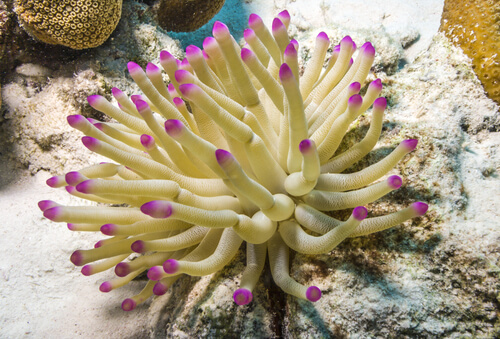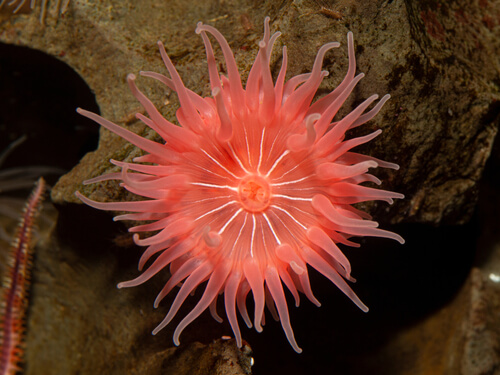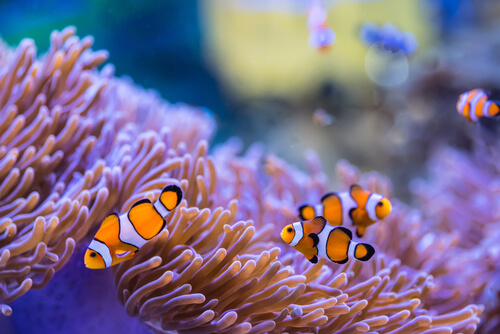
| Kingdom | Animalia |
| Phylum | Cnidaria |
| Class | Anthozoa |
| Order | Actiniaria |
| Family | 46 families |
| Niche | Benthic predator |
| Length | 0.4-2.0 in (1-5 cm) |
| Lifespan | Up to 50 years |
| Social Structure | Not social |
| Conservation Status | Not endangered |
| Preferred Habitat | Benthic marine habitats |
| Average Clutch Size | 100-1,500 eggs |
| Main Food Items and Prey | Crustaceans, small fish, mollusks |
| Predators | Fish, sea stars, predatory marine snails |
The Basics
The sea anemone is a sessile marine predator of the order Actiniaria. They are named after a terrestrial flower due to their radially symmetric appearance and many tentacles. Most species appear as a single polyp attached to a hard surface such as a rocky or coral reef.

Most sea anemones measure between 0.4-2.0 inches in diameter. However, some species such as Urticina columbiana and Metridium farcimen are much larger, growing up to one meter. Their flowery tentacles generally sit atop a basal disc which attaches them to the substrate. In its center is an ‘oral disc’ through which it ingests food. Tentacles are normally tapered and are covered with many cnidocytes – cells similar to those present in many jellyfish species that can sting their prey or predators.
Distribution and Habitat
Sea anemones can be found throughout the world’s oceans, typically living benthic lifestyles. Other species may be pelagic, effectively floating through the ocean, while others may burrow into soft sediments and use a bulbous base to anchor themselves.
Some species such as the giant green anemone live in the intertidal zone, spending part of each day exposed above the tide line and at risk of desiccation (drying out). In contrast, other species live at depths of up to hundreds of feet. Most species diversity can be found in the tropics but many species are adapted to colder waters as well.
Diet and Predators
Most anemones are predatory. They use the stinging cells in their tentacles to stun and grasp their prey, often paralyzing it with toxins before moving it towards their oral cavity for digestion. Common prey species for the anemone include various crustaceans such as crabs and shrimp-like organisms. Many small fish and mollusks such as mussels may also fall victim to the predatory sea anemone.
Many anemone species form symbiotic relationships with plants. Indeed, single-celled algae such as zooxanthellae and zoochlorellae often live within the gastrodermis of the anemone’s tentacles and oral disc. The anemone can harvest some of the energy produced by these photosynthetic organisms in the form of glycerol, glucose, and alanine. This forms an important supplement to their diet.
Despite their protective nematocysts, sea anemones – particularly those that are not fully developed – still face the threat of predation from a host of species. Various fish and crustaceans, especially those that normally feed on zooplankton, will eat young anemones as they float in the water column. Others will consume juvenile anemones even after they have developed stinging cells and settled onto the seafloor. This is likely why sea anemones generally congregate in crevices and cracks in reefs and may often live on the underside of submerged timber as well.

Reproduction
Sea anemones are broadcast spawners and send their sperm and eggs (gametes) into the water column, often in synchronized spawning events. Once fertilized, eggs develop to a ‘planula larva’ which will remain part of the zooplankton community until they develop directly into a polyp. At this point in most species, it will settle onto the seafloor and become a benthic organism for the remainder of its life cycle.
In many species of sea anemone, sexes are separate. Other species, however, such as the brooding anemone (Epiactis prolifera), are sequential hermaphrodites and change sex at some point in their lives. In addition, sea anemones are often capable of reproducing asexually by budding, fragmentation, or by longitudinal or transverse binary fission, all forms of effectively cloning themselves.
Most sea anemone species are not threatened. However, the degradation of marine habitats around the world combines with the threat of global climate change means that many populations face pressures. An added threat is the increasing demand for sea anemones in the global aquaria trade.
Fun Facts about the Sea Anemone!
Sea anemones are fascinating organisms and have long drawn the interest of researchers and ocean lovers alike. They have many unique properties including their symbiotic relationships with various organisms as well as some fascinating regeneration abilities.

Related to Jellyfish and Coral
As a member of the phylum Cnidaria, sea anemones are related to corals, jellyfish, tube-dwelling anemones, and Hydra spp. When one considers the polyp-shape of corals or the notorious presence of cnidocytes in jellyfish, this is not overly surprising.
All sea anemones belong to the class Anthozoa, of which there are three subclasses: Octocorallia, Ceriantharia, and Hexacorallia. To the latter belong the order Actiniaria and all 45 of its sea anemone families. The phylogenetic relationships within the class Anthozoa are not well understood, particularly within these three subclasses. Indeed, recent DNA analysis suggests that some species of anemone may indeed exist outside of the order Actiniaria. This only further highlights the complexity of studying phylogenetic relationships, particularly in species with virtually no hard parts that can be preserved in the fossil record.
Cnidocytes and Nemadocysts
Much like jellyfish, which are famous for their ability to ‘sting’ their prey and potential predators, sea anemones possess cnidocytes – specialized ‘stinging cells’. Within each cnidocyte are organelles (small organ-like structures) known as nematocysts. These are the ‘stingers’ and in anemones are present mostly in the area of the oral disc as well as the tentacles.

Within each cnidocyte, the nematocyst contains many coiled, barbed threads. On the outside of the cnidocyte, a hairlike structure known as a scnidocils sits. These structures are sensitive to touch and, once touched, trigger the nematocysts to uncoil and penetrate their prey (or predator). In many cases, these nematocysts also deliver toxins known as actinotoxins, that can immobilize the victim.
Actinotoxins are highly toxic to prey species of fish and crustaceans. However, Amphiprioninae (clownfish), small banded fish in various colors, are not affected by their host anemone’s sting and shelter themselves from predators among its tentacles. Several other species have similar adaptions and are also unaffected.
At the base of the tentacles in some species are elongated, inflatable, tentacle-like organs known as acrorhagi. These are armed with cnidocytes and are used to fend off other encroaching anemones.
Most sea anemones are harmless to humans, but some highly toxic species do exist. Actinodendron arboreum, Phyllodiscus semoni, and Stichodactyla spp., for example, are known to cause severe injuries and are even potentially lethal to humans.
Chloro-Filled
Beyond their symbiosis with clownfish and other species immune to the anemone’s stinging-cells, they are also well known for another symbiotic relationship that they form with plants. Indeed, single-celled algae known as zooxanthellae and zoochlorellae are often observed living within the dermal cells of anemones. These are normally concentrated in the tips of their tentacles and other upward-facing parts of the anemone’s bodies.
This relationship is known to be mutually beneficial to both species, as the algae avoid being consumed by herbivorous species as they float through the sea while the anemone is able to utilize some of the oxygen produced by the algal cells as well as its energy in the form of glycerol, glucose, and alanine. This forms an important supplement to the anemone’s diet which is otherwise carnivorous, using its stinging cells to paralyze and consume various prey species.
